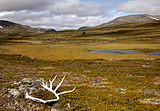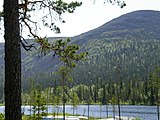Fjell

The Fjell ( Norway ), Fjäll ( Sweden ), Fjall ( Iceland ) and Tunturi ( Finnish ) correspond to the alpine vegetation level of the Fennoscandinavian mountains.
The term fell from the Old Norse language into English and also describes the treeless heights in northern England (especially in the Lake District ), Scotland and the Isle of Man . In New Zealand , the treeless region of the mountains is known as the fellmark .
General characterization
Fjell (cf. German rock ) is a term for mountains or plateaus above the coniferous forest border . The Norwegian word fjell and the Swedish fjäll actually only mean "mountains". In Scandinavian geography, all Nordic mountains with a glacial character (small relative height differences, rounded shapes, U-valleys) are referred to as fells or fells. In ecology, this usually means the mountain tundra above the tree line. In German, the word was adopted to denote the type of high mountain range that is particularly prevalent in western and northern Scandinavia .
In the Scandinavian mountains of Norway and Sweden , the fells usually form extensive plateaus. The landscape is glacial and mostly wavy or hilly. Lakes often form in the depressions. The vegetation at the edge of the forest consists of squat mountain birch ( Betula pubescens subsp. Tortuosa ), above it of dwarf shrub heather and on the edge of the rocky region of grasses, mosses, herbs and lichens.
In Finland , the mountains typical of the Lapland region are called tunturi (plural: tunturit ). They are round island mountains that rise from the otherwise flat surroundings. The mountains in Finnish Lapland reach heights between 400 and 800 meters, with the upper areas above the tree line. Mountains that do not reach the tree line, on the other hand, are usually referred to as vaara . The mountains in Finnish Lapland are remnants of the Karelid Mountains, which formed two billion years ago and were abraded by the glaciers of the Ice Age . The Finnish name tunturi is etymologically related to the word tundra .
Altitude levels
Compared to the Alps, the limits of the altitude levels in the Fjell Mountains are significantly lower. While the tree line - which is formed from coniferous trees in Central Europe - is between 2000 and 1500 m above sea level in the Alps or 1000 m above sea level in the Harz , it is - formed there by the downy birch - at 1100 m in southern Norway and in northernmost Scandinavia only at 500 m.
The mountain tundra - the same fell - corresponds to the alpine altitude. The last mountain birches are followed in damp areas by a dense belt of various head-high, shrub-shaped, arctic willows . In drier areas, the forest or willow bushes change into dwarf shrub heaths with blueberries , lingonberries , crowberries , dwarf birches and other shrubs. The higher you go, the more dominant grasses , shrub lichen ( reindeer lichen, etc.) and herbs become. In the mid-alpine fells, only perennial grasses and the specially adapted plants of the so-called snow depressions grow . The frost rubble belt is only an acceptable habitat for mosses and stone lichens (e.g. map lichen ).
Picture gallery
Typical, rounded fell mountains in the Vindelfjällen nature reserve, Sweden ...
... and in the Vistasvagge at Nikkaluokta
The Kebnekaise massif in the Swedish Fjell
Tree line at Yllästunturi in Northern Finland
literature
- Angelika Lang, Sven Halling, Detlef Singer: Nature guide: Northern Scandinavia with Finland. BLV, Munich 1994.
- Eckart Pott , Werner Küpker: Travel Guide Nature: Southern Scandinavia. BLV, Munich 1991.
- Norbert Schwirtz, Winfried Wisniewski: Sweden - Finland. Landscapes, animals, plants. Landbuch Naturreisführer, Hannover 1990.
- Hans-Dieter Haas, Hartmut Leser, Thomas Mosimann: Diercke - Dictionary of General Geography . Deutscher Taschenbuch Verlag, ISBN 3-423-03417-3 .
Individual evidence
- ↑ Michael Richter (author), Wolf Dieter Blümel et al. (Ed.): Vegetation zones of the earth. 1st edition, Klett-Perthes, Gotha and Stuttgart 2001, ISBN 3-623-00859-1 . P. 304.
- ↑ Lars Andersson, Thomas Rafstedt, Ulf von Sydow: Fjällens vegetation. Norbottens län. Statens Naturvårdsverk, Solna 1985, ISBN 91-7590-202-8 , pp. 6-11.








